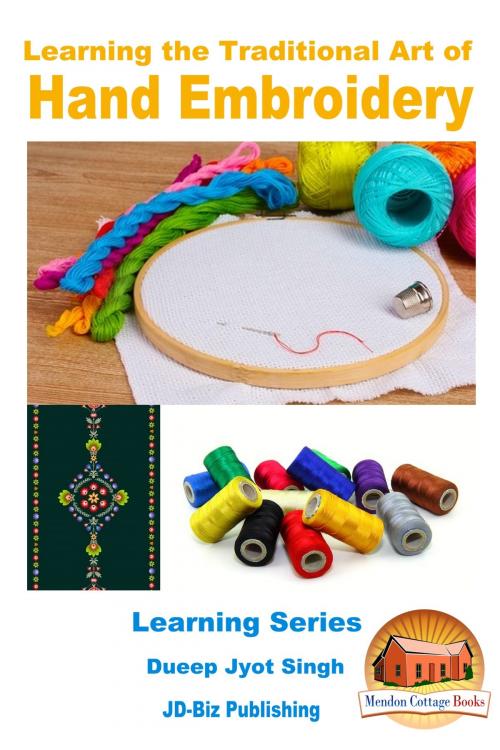Learning the Traditional Art of Hand Embroidery
Nonfiction, Home & Garden, Crafts & Hobbies, Needlecrafts & Fabric, Needlework| Author: | Dueep Jyot Singh | ISBN: | 9781310609909 |
| Publisher: | Mendon Cottage Books | Publication: | March 19, 2016 |
| Imprint: | Smashwords Edition | Language: | English |
| Author: | Dueep Jyot Singh |
| ISBN: | 9781310609909 |
| Publisher: | Mendon Cottage Books |
| Publication: | March 19, 2016 |
| Imprint: | Smashwords Edition |
| Language: | English |
Table of Contents
Introduction
General Principles of the Embroidering Art
Selection of Pattern
Pattern Position
Pattern Laying on the Cloth
Things needed
Embroidery Needles
Selection of the Best Thread
Threading During Embroidery
Finishing and Starting Yarn
Working with an Embroidery Hoop –
Transferring the Pattern
Copying The Design onto Another Paper/Fabric
Different Traditional Stitches of Embroidery
Flat Stitch Group
Tacking Stitch And Running Stitch
Backstitch
Stem Stitch Also Known As Outline Stitch
Straight Stitch
Satin Stitch
Long and Short Stitch.
Flat Stitch
Fishbone and Open Fishbone Stitch
Loop Stitch Group
Blanket Stitch And Buttonhole Stitch
Feather Stitch
Double Feather Stitch
Fly Stitch, Open Attached Fly Stitch, and Closed Attached Fly Stitch
Chain stitch group
Open Chain Stitch
Twisted Chain Stitch
Lazy Daisy, Wheat Ear, and Attached Wheat Ear Stitches
Knotted Stitches Group
French Knot Stitch
Coral Stitch
Bullion Stitch
Finishing Your Project
Blocking Your Design
Mounting
Appendix
Conclusion
Author Bio
Publisher
Introduction
A thing of beauty is a joy forever and Curly Locks sitting on a silk cushion and sewing a fine seam after dining off strawberries and cream are 2 clichés which have everything to do with keeping oneself adorned with something beautiful, made by one’s own hands.
The instinct of beautifying one’s house and surroundings and also one’s clothes is innate in a human being. And that is why traditional designs incorporated designs, including natural symbols and figures like flowers, animals, leaves, and birds, through needle and thread on a base.
Women used fishhooks and ivory needles 5000 years ago with fiber from plants like cotton thread, jute thread, and even silk thread. Even today, natural fibers are used for embroidery including silk.
We do not know which particular civilization where and how long ago decided to embellish the garments one wore with embroidery. But we do know that ancient civilizations more than 5000 years ago had experts in the art of needle and thread and their families, and these housewives were proud to demonstrate their creative abilities to everyone who came to visit and admire.
When the Spaniards conquered the Philippines, – 1521 to 1799- they wanted to show the natives that they were the conquerors and that is why they ordered them to wear their traditional shirt- Canga untucked in their loin cloths -bahags. The Filipinos in order to show that they were not conquered decorated these shirts with such exquisite embroidery, that each shirt worn became an admirable barong tagalog. When I was young, I had a number of these sent to me by my aunt in the Philippines, – shirts for ladies – which I wore when at college to the great admiration of all my fellow classmates.
You can look at some of the examples in the Appendix and throughout the book. Each of them took anywhere between one and a half years to 3 years to make by hand by my skilled artisan friends through state aided societies for the upliftment of women.. They are now being sold all over the world through nonprofit organizations and the money going straight to the women.
Traditionally, any surface which was present and visible would be embroidered upon and embellished with patterns. So this book is going to tell you all about how you can learn the traditional art of hand embroidery. After that you can try your hand at your own designs.
Table of Contents
Introduction
General Principles of the Embroidering Art
Selection of Pattern
Pattern Position
Pattern Laying on the Cloth
Things needed
Embroidery Needles
Selection of the Best Thread
Threading During Embroidery
Finishing and Starting Yarn
Working with an Embroidery Hoop –
Transferring the Pattern
Copying The Design onto Another Paper/Fabric
Different Traditional Stitches of Embroidery
Flat Stitch Group
Tacking Stitch And Running Stitch
Backstitch
Stem Stitch Also Known As Outline Stitch
Straight Stitch
Satin Stitch
Long and Short Stitch.
Flat Stitch
Fishbone and Open Fishbone Stitch
Loop Stitch Group
Blanket Stitch And Buttonhole Stitch
Feather Stitch
Double Feather Stitch
Fly Stitch, Open Attached Fly Stitch, and Closed Attached Fly Stitch
Chain stitch group
Open Chain Stitch
Twisted Chain Stitch
Lazy Daisy, Wheat Ear, and Attached Wheat Ear Stitches
Knotted Stitches Group
French Knot Stitch
Coral Stitch
Bullion Stitch
Finishing Your Project
Blocking Your Design
Mounting
Appendix
Conclusion
Author Bio
Publisher
Introduction
A thing of beauty is a joy forever and Curly Locks sitting on a silk cushion and sewing a fine seam after dining off strawberries and cream are 2 clichés which have everything to do with keeping oneself adorned with something beautiful, made by one’s own hands.
The instinct of beautifying one’s house and surroundings and also one’s clothes is innate in a human being. And that is why traditional designs incorporated designs, including natural symbols and figures like flowers, animals, leaves, and birds, through needle and thread on a base.
Women used fishhooks and ivory needles 5000 years ago with fiber from plants like cotton thread, jute thread, and even silk thread. Even today, natural fibers are used for embroidery including silk.
We do not know which particular civilization where and how long ago decided to embellish the garments one wore with embroidery. But we do know that ancient civilizations more than 5000 years ago had experts in the art of needle and thread and their families, and these housewives were proud to demonstrate their creative abilities to everyone who came to visit and admire.
When the Spaniards conquered the Philippines, – 1521 to 1799- they wanted to show the natives that they were the conquerors and that is why they ordered them to wear their traditional shirt- Canga untucked in their loin cloths -bahags. The Filipinos in order to show that they were not conquered decorated these shirts with such exquisite embroidery, that each shirt worn became an admirable barong tagalog. When I was young, I had a number of these sent to me by my aunt in the Philippines, – shirts for ladies – which I wore when at college to the great admiration of all my fellow classmates.
You can look at some of the examples in the Appendix and throughout the book. Each of them took anywhere between one and a half years to 3 years to make by hand by my skilled artisan friends through state aided societies for the upliftment of women.. They are now being sold all over the world through nonprofit organizations and the money going straight to the women.
Traditionally, any surface which was present and visible would be embroidered upon and embellished with patterns. So this book is going to tell you all about how you can learn the traditional art of hand embroidery. After that you can try your hand at your own designs.















